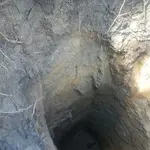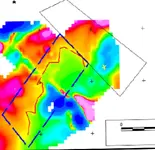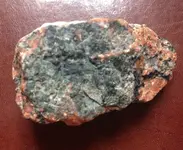You are using an out of date browser. It may not display this or other websites correctly.
You should upgrade or use an alternative browser.
You should upgrade or use an alternative browser.
Got A Rock you Want Identified? Post it here! gimme a good picture or 3 or 4!
- Thread starter Dustedyou
- Start date
Eu_citzen
Gold Member
Quartz. As a aspiring miner/mine owner, it's one of the minerals you'll quickly want to learn to recognize.
Gaiton6729Zippo
Tenderfoot
Howdy EU: Thanks for the ID on the rock. It sure helps to have someone to ID these pieces . Thanks
aussie skeeta
Tenderfoot
- Joined
- Mar 8, 2017
- Messages
- 7
- Reaction score
- 0
- Golden Thread
- 0
- Primary Interest:
- All Treasure Hunting
For educational purposes, do a streak test with the ironstone sample. Compare. Sounds like a relative to your ironstone.
Limonite, FeOH, or commonly called rust typically shows the streak you got in this rock. Happens to be a major part of ironstones.
Boxwork pattern can be due to jointing. (the non-smoke variation in geology)
Hi EU
yes it is very similar to the iron stone in every way but looks , as one has an outer shell like an egg,was even round but flat, found separate in the creek banks, and the other(pictured) has formed in a layer(pictured) , and has broken into these shapes , the vessels inside the rocks are a little different too,compared to the Iron Stone, they are bigger ,
so done a streak test on the iron stone, just depends on where you do it
on the back (not the cut face )i done it to the center and got a dark brown streak(middle top)
on the outside of the egg i got a yellowy brown streak(left)
on the outside of the eggi got a brown streak(right)
on the back i done it to the point of break and got a light grey slightly green(middle bottom)

still a novice at all of this really ,this helps a lot ,appreciate your time
thanks
aussie skeeta
Tenderfoot
- Joined
- Mar 8, 2017
- Messages
- 7
- Reaction score
- 0
- Golden Thread
- 0
- Primary Interest:
- All Treasure Hunting
Appears to be iron-rich for sure. The limonite may form a oxidazation layer around other minerals, hence forming a outer layer in this way.
The surface looks polished, rather then fusion crust.
Please do take pic of the one broke in half.
My initial impression is still sedimentary-rock related. Ironstone, banded iron formation? Let's see the inside!
Hi EU
I can positively say that i have not polished this rock ,has had a wash under the tap to get the small amount of clay off it ,but other than that it has sat on my display shelf for the last 5 years in this condition,as mentioned it was tangled in the roots of a large tree ,suspended ,the sun was shining on it ,so i just had to climb in there to retrieve it ,just next to the tree there was a small section of the creek bank that had a lot of these coming out ,mostly smaller ones , with breaks and chips , but all had this coating on the ,some of them are magnetic (very)snap to the magnet,but the most are not, the ground in this section has a lot of whitish and yellow clay , and pinky to purple clay




we also are thinking that we might have a situation of hydrothermal events in the area ?,knowing that the area was volcanic eons ago , and that it was a shallow body of water too , not sure if that helps
Eu_citzen
Gold Member
found in tucson, az
View attachment 1427458
Looks like quartz with sulphides. Nice find! I'd test it for precious metals.
Eu_citzen
Gold Member
Hi EU
yes it is very similar to the iron stone in every way but looks , as one has an outer shell like an egg,was even round but flat, found separate in the creek banks, and the other(pictured) has formed in a layer(pictured) , and has broken into these shapes , the vessels inside the rocks are a little different too,compared to the Iron Stone, they are bigger ,
so done a streak test on the iron stone, just depends on where you do it
on the back (not the cut face )i done it to the center and got a dark brown streak(middle top)
on the outside of the egg i got a yellowy brown streak(left)
on the outside of the eggi got a brown streak(right)
on the back i done it to the point of break and got a light grey slightly green(middle bottom)View attachment 1427557
still a novice at all of this really ,this helps a lot ,appreciate your time
thanks
Both streaks are typical of limonite, which in reality is a group of minerals. However for the sake of keeping it simple, usually just referred to as limonite.
That's why a slight variation of streaks can occur.
Ironstone can have zoning, don't let the looks deceive you. In fact, boulder opal (opal in ironstone) often shows zoning, to:

Magnetism is likely explained by magnetite or traces there of.
Hydrothermal activity is typically associated with quartz veins, calcite veins and the likes. If you find those, I'd bet its traces of hydrothermal activity.
aussie skeeta
Tenderfoot
- Joined
- Mar 8, 2017
- Messages
- 7
- Reaction score
- 0
- Golden Thread
- 0
- Primary Interest:
- All Treasure Hunting
Both streaks are typical of limonite, which in reality is a group of minerals. However for the sake of keeping it simple, usually just referred to as limonite.
That's why a slight variation of streaks can occur.
Ironstone can have zoning, don't let the looks deceive you. In fact, boulder opal (opal in ironstone) often shows zoning, to:

Magnetism is likely explained by magnetite or traces there of.
Hydrothermal activity is typically associated with quartz veins, calcite veins and the likes. If you find those, I'd bet its traces of hydrothermal activity.
Gday EU
thanks again for your time ,more food for thought .
rios
Jr. Member
SaltwaterServr
Sr. Member
That is a good example of gold ore. The large black, red, and orange band cutting through it horizontally is hematite and limonite. It's also hematite and limonite in the horizontal group of bands dead center of the specimen as well as the band coming in diagonally from bottom left almost meeting up with that large band. The yellow splotch on the upper left might be some kind of sulfide.
Quartz can be stained black from mineralization. I have some samples that range from bright orange to almost red. I'll put a few here.
Quartz outcrop

Copper rich quartz sample

Heavily stained gold ore

Eu_citzen
Gold Member
This shaft is 8m deep and has produced the rocks below in the order of the pictures. What are the rocks? They have no gold as of yet
View attachment 1428826
View attachment 1428827
View attachment 1428829
#1 Uncertain.
#2 Granitoid, perhaps.
#3 Would need a better close-up.
Eu_citzen
Gold Member
Really need helpView attachment 1429276
Easy, that's an agate.
Ibjilln
Tenderfoot
- Joined
- Mar 20, 2017
- Messages
- 1
- Reaction score
- 0
- Golden Thread
- 0
- Location
- Prince Edward Island
- Primary Interest:
- All Treasure Hunting
CooperCabra
Tenderfoot
- Joined
- Mar 5, 2017
- Messages
- 2
- Reaction score
- 2
- Golden Thread
- 0
- Primary Interest:
- All Treasure Hunting
Eu_citzen
Gold Member
Hi,
I've had this rock for almost twenty years and I've always been curious as to what kind it is and especially curious about the purple and white mineral/quartz.
View attachment 1429613
View attachment 1429614
View attachment 1429615
Most of it is quartz. The purple might be amethyst. The pinkish/reddish is K feldspar. Neat find!
Eu_citzen
Gold Member
***can anyone help identify my finds and help end the madness!! I'm from San Bernardino County and I've found some interesting specimens near San Gabriel River and SBNF.View attachment 1429852View attachment 1429861View attachment 1429860View attachment 1429858View attachment 1429857View attachment 1429856View attachment 1429855View attachment 1429854View attachment 1429853View attachment 1429862
Try taking new, less blurry pics. Also, limit the specimens posted to 3-4/post. Makes it easier on me.
I do see some quartz, sulphides. The yellowish stained rocks are colored from iron - possibly decomposing pyrite.
That's about all I can say from these pics.
Eu_citzen
Gold Member
Hi
I found this rock closed to an oil field in the desert in north Africa
Is there any gold could get from it
ThanksView attachment 1429885
Only one way to find out, try it. Crush and pan, or have it assayed. Has gold been found in the area before? If yes, chances are it's worth looking into.
Similar threads
- Replies
- 8
- Views
- 2K
- Replies
- 1
- Views
- 961
- Suggestion
- Replies
- 3
- Views
- 3K
Users who are viewing this thread
Total: 1 (members: 0, guests: 1)


























